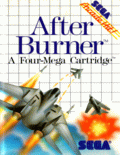
































After Burner

After Burner is an arcade vehicular combat game developed and released by Sega in 1987. The player assumes control of an American F-14 Tomcat fighter jet, and must clear each of the game's eighteen unique stages by destroying incoming enemies, using both a machine gun and a limited supply of heat-seeking missiles. It uses a third-person perspective, previously utilized by Sega's earlier games Space Harrier (1985) and Out Run (1986), and runs on the Sega X Board arcade system, which is capable of surface and sprite rotation. It is the fourth Sega game to use a hydraulic 'taikan' motion simulator arcade cabinet, one that is more elaborate than their earlier 'taikan' simulator games. The cabinet simulates an aircraft cockpit, with flight stick controls, a chair with seatbelt, and hydraulic motion technology that moves, tilts, rolls and rotates the cockpit in sync with the on-screen action.
Designed by Sega veteran Yu Suzuki and the Sega AM2 division, After Burner was intended as being Sega's first 'true blockbuster' video game. Development began in December 1986, shortly after the completion of Out Run, and was kept as a closely guarded secret within the company. Suzuki was inspired by the 1986 films Top Gun and Laputa: Castle in the Sky; he originally planned for the game to have a steampunk aesthetic similar to Laputa, but instead went with a Top Gun look to make the game approachable for worldwide audiences. It was designed outside the company in a building named 'Studio 128', due to Sega adopting a flextime schedule to allow for games to be worked outside company headquarters. An updated version with the addition of throttle controls, After Burner II, was released later the same year.
After Burner was a commercial success, becoming Japan's second highest-grossing large arcade cabinet of 1987 and overall highest-grossing arcade game of 1988, while also becoming one of America's top five highest-grossing dedicated arcade games of 1988 and topping the monthly UK arcade charts in 1987. It was acclaimed by critics for its impressive visuals, gameplay and overall presentation, and is seen as being important and influential. It was followed by a series of sequels and ports for many platforms, including the Sega Master System, ZX Spectrum and Nintendo Entertainment System. Sega also produced several successors to the game to capitalize on its success, such as G-LOC: Air Battle. After Burner has also been referenced in many other Sega video games, such as Fighters Megamix, Shenmue and Bayonetta.
The game allows the player to control an F-14 Tomcat jet airplane. The player's mission is to destroy enemy jets over 18 stages. At the start of the game, the player takes off from an aircraft carrier called the SEGA Enterprise, which shares a similar name to the one used in the 1986 film Top Gun (also a reference to the company's name at the time, SEGA Enterprises, LTD.).
In the arcade version, the jet employs a machine gun and a limited number of heat-seeking missiles (in the Master System version the player has unlimited missiles). These weapons are replenished by another aircraft, after beating a few stages. The aircraft, cannon and missile buttons are all controlled from an integrated flight stick.
The game itself was released in two variations in the US: a standard upright cabinet and a rotating cockpit version. In the cockpit version, the seat tilted forward and backwards, and the cockpit rotated from side to side. It featured two speakers at head-level for stereo sound, and had a seatbelt to hold the player when the cockpit moved. Both cabinets contained a grey monitor frame with flashing lights at the top that indicated an enemy's 'lock' on the player's craft. Japan also received a commander cabinet that moved left and right.
The SEGA Master System adds a boss fight at the very end. Despite being called After Burner, all other console / computer ports are based on After Burner II.
How to play:
Click on the joystick icon in the After Burner online emulator to see how to control the After Burner game









































Comments